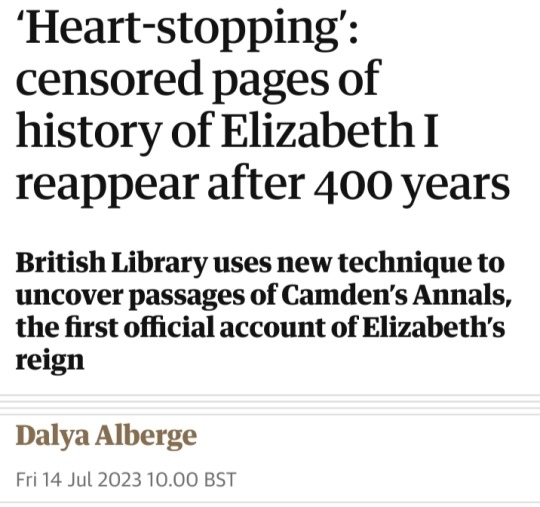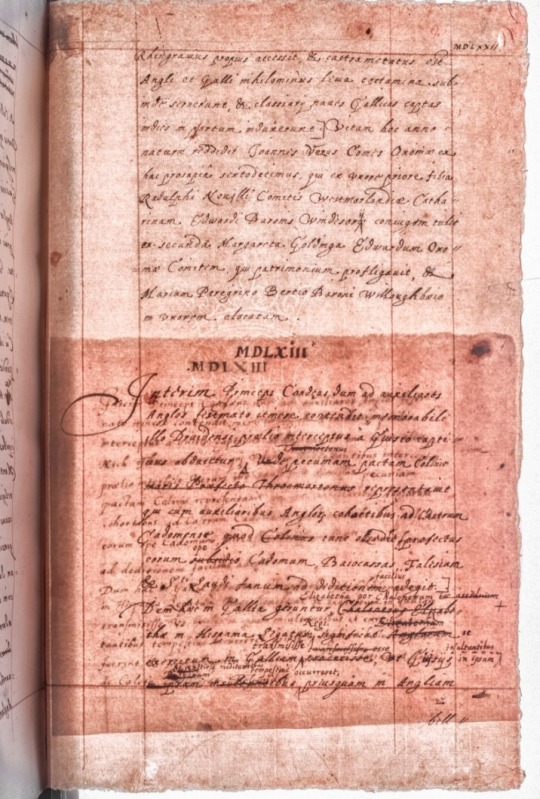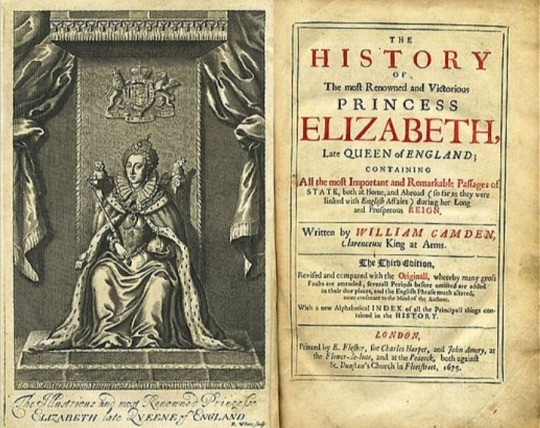#william cecil
Text

I was trying to redraw a scene from Elizabeth I (2005) but I think I went overboard
#art#digital art#artists on tumblr#my art#Elizabethan Era#Elizabeth i#Francis Walsingham#William Cecil#Lord Burghley#Robert Cecil#Earl of Salisbury#digital painting#digital illustration#fanart
26 notes
·
View notes
Text
The extent of Hatton’s links with Catholics inevitably calls for some explanation of how this was possible in a regime which has often been regarded as reflexively anti-Catholic. In many ways the most surprising thing is how little this appears to have affected Hatton’s career. If Hatton indeed was some kind of Catholic, or even simply an unusually strong enemy of the Puritans, what does this say about the regime and Hatton’s place in it? Ultimately, this can only be answered by looking at the Queen herself. In short, Hatton’s career suggests that Elizabeth was not especially concerned if her servants were, or were widely believed to be, either Catholic or something close to it. Hatton’s protection of Catholics was clearly against the spirit of the law, and in some senses a kind of challenge to the authority of the regime, the law and the Queen. Elizabeth promoted him all the same, surely knowing what he was doing and what people said about him. We can surely not regard that as an accident.
This might suggest that Elizabeth was simply pursuing a ‘secular, disengaged’ approach to politics, that she was unconcerned about Hatton’s religion and was promoting him because she liked him. This is quite interesting in itself; the notion that we might easily overstate the level of interest that nobles and royals of this period had in religious differences seems quite plausible. However, another possibility is that Elizabeth promoted Hatton (and perhaps others) because of his religious attitudes, using her choice of councillors to send signals to the wider population (Hatton’s prominence as a public face for the regime’s politics is again relevant here). Since this was not a police state, much political activity can be seen as signaling about what was acceptable and what was not at any given moment. Hatton’s prominence demonstrated that Elizabeth was not a bigot, but tolerated Catholics or their favourers. One virtue of using Hatton to demonstrate this was that he was her creation; if Elizabeth acceded to powerful conservative nobles like Norfolk, she looked weak; by using her own man, she could look strong and magnanimous. This also showed that she was not a puppet of the Protestants, of Leicester and Burghley, who were often claimed to be in effect holding her captive, but that she had her own agenda. Hatton was a living demonstration of the Queen’s moderation, and, perhaps, a model of loyal Catholicism. Catholics who behaved themselves, stayed loyal, and were prepared if necessary to roundly criticize the Pope were acceptable, and windows would not be made into their souls. This was of course a marked contrast with Burghley’s approach of drawing clear boundaries between Protestants and Catholics, trustworthy and not, loyal and traitor – as we see in the Bond of Association, the lord lieutenancies and other plans.
Neil Younger, Religion and politics in Elizabethan England: The life of Sir Christopher Hatton
#Neil Younger#non-fiction#Christopher Hatton#Elizabeth I#Elizabeth I of England#Elizabeth Tudor#Elizabethan England#William Cecil
13 notes
·
View notes
Text
Can we all agree that the main villain of Mary Queen of Scots's demise and failed reign is not Elizabeth I or Cecil or Walsingham or anyone at the English court?
It's actually Lord D*rnley. *Mic drop*
#i said what i said#he's a piece of shit#disgusting idiot#HATE HIM#filled with rage#this is the same dude who had her friend killed in front of her whilst she was pregnant#stuartposting#stuarts#tudors#elizabeth i#william cecil#sir francis walsingham#mary queen of scots#not even tagging the other one#we have a pretty witty queue
7 notes
·
View notes
Text
Shoutout to the dictation software on my laptop that transcribed 'Cecil' as 'Sessile'
18 notes
·
View notes
Text
In March 1559, the Spanish ambassador informed his master, King Philip, that he had made overtures to Katherine Grey. ‘She is a friend of mine,’ he wrote, ‘and speaks confidentially to me, [she] told me that the Queen does not wish her to succeed in case of her [the Queen’s] death without heirs. She [Katherine] is dissatisfied and offended at this... I try to keep Lady Katherine very friendly and she has promised me not to change her religion, nor to marry without my consent.’? Little escaped William Cecil, the Queen’s chief minister: Katherine Grey was closely watched. In October 1559 one of Cecil’s informants reported Spanish plans to abduct Katherine and marry her to King Philip’s heir, a Spanish balance to the Scots Queen’s marriage to the King of France. It would mean certain war between France and Spain at Elizabeth’s death, with England their battlefield.
-Tudor Cousins Rivals For Throne by Dulcie M. Ashdown
3 notes
·
View notes
Text
OTD, November 17th 1558, the 25 year old Princess Elizabeth ascends to the throne after the death of her half sister. She will go on to rule England for 44 years 👑❤️

#elizabeth#becoming elizabeth#princess elizabeth#queen elizabeth#queen of england ireland and france#hatfield house#kat ashley#william cecil#robert dudley#henry viii#anne boleyn#tudor#tudors#semper eadem#👑❤️
7 notes
·
View notes
Link
William Cecil, 1st Baron Burghley was an English statesman, the chief adviser of Queen Elizabeth I for most of her reign, twice Secretary of State and Lord High...
Link: William Cecil, 1st Baron Burghley
0 notes
Text



It was the first official account of Elizabeth I’s reign, one of the most valuable sources on early modern Britain, commissioned by her successor, King James I.
But, for 400 years, no one has been able to read passages on hundreds of pages of this manuscript because they had been so heavily revised and self-censored by their 17th-century author, apparently to avoid punishment for offending his patron.
Now state-of-the-art imaging technology has enabled the British Library to read hidden pages of William Camden’s Annals for the first time, “a significant finding in early modern historical scholarship.”
Those pages had been either over-written or concealed beneath pieces of paper stuck down so tightly that attempting to lift them would have ripped the pages and destroyed evidence.
Enhanced imaging technology, involving transmitted light, has revealed those texts, offering new insights into the queen and the political machinations of her court, to the excitement of scholars.
It casts new light on significant historical episodes such as Elizabeth’s excommunication by Pope Pius V and her nomination of James as her successor.

Julian Harrison, the British Library’s lead curator of medieval historical and literary manuscripts, told the Guardian that seeing unknown passages emerge for the first time was “heart-stopping.” He said:
“It’s really one of those moments where ‘now you can’t see anything, now you can,’ the absolute reversal of ‘now you see it, now you don’t.’
The imaging is revolutionary. We’ve never done anything quite like this before. It’s just incredible.”
Written in Latin, the Annals were based on first-hand evidence such as witness reports and official parliamentary records collected by Camden, who died in 1623.
Harrison said:
“We have 10 volumes of the handwritten manuscripts … [of which] literally several hundred pages … [have] passages which had been covered up.”
He added:
“Modern historians have commonly relied on Camden’s Annals as an impartial and supposedly accurate record.
This new research reveals that key sections were revised … It implies that Camden’s Annals were deliberately rewritten to present a version of Elizabeth’s reign that was more favourable to her successor.”
He noted, for example, its claim that Elizabeth I had named James VI of Scotland as her successor on her deathbed:
“Elizabeth never married and she died childless in 1603, to be succeeded on the English throne by Mary’s son, James VI of Scotland.
Analysis of the manuscript drafts shows that the deathbed scene was a fabricated addition that Camden did not intend originally to put into his history.
He presumably included it to appease James so that his succession looked more predetermined than it had actually been.
Elizabeth was too ill to speak in her final hours and no other historical evidence points to this deathbed scene being true.”

In 1570, Pope Pius V excommunicated Elizabeth.
Harrison said Camden originally said the pope was motivated to do so by “spiritual warfare,” only to replace it in the published version with the statement that Pius was creating “secret plots” against Elizabeth:
“By removing the previously inflammatory wording, Camden made the official record more neutral in tone.”
Historians will now want to pore over this material.
“There’s still more to be discovered,” Harrison said. “What’s going to be interesting is how modern interpretations of Elizabeth I, such an important historical figure, are potentially going to be changed.”
The researcher Helena Rutkowska has been working on the Annals as part of a collaborative doctoral award in a partnership between the University of Oxford, where she is a DPhil student, the British Library, and the Open University.
She spoke of the excitement of seeing original texts for the first time:
“It was incredible … We’ve been able to clearly see new information that no one has seen for 400 years.”


—
Camden's Annals has long been regarded as one of the most important, contemporary accounts of the reign of Queen Elizabeth I (7 September 1533 – 24 March 1603).
The work was originally requested by William Cecil, 1st Baron Burghley KG PC (13 September 1520 – 4 August 1598), and was then completed by command of King James I of England and VI of Scotland (19 June 1566 – 27 March 1625).
William Camden (2 May 1551 – 9 November 1623), an antiquarian scholar and Clarenceux King of Arms, is credited with authorship of the work, but he was probably writing in collaboration with others, including Sir Robert Bruce Cotton, 1st Baronet (22 January 1570/71 – 6 May 1631), founder of the famous Cotton library.
The first three books, covering the period to 1587, were published in Latin in 1615, with the remainder of the work published after Camden had died, in 1625.


#Queen Elizabeth I#William Camden’s Annals#Enhanced imaging technology#Camden's Annals#William Cecil#King James I of England and VI of Scotland#William Camden#Sir Robert Bruce Cotton#Julian Harrison#Helena Rutkowska#British Library#House of Tudor#Tudor Dynasty#Tudor Queen#Pope Pius V#medieval history#literary manuscript#1500s#16th century#history#British Royal Family#british history
0 notes
Text










collected doodles from the specialist little guy tournament ☝️☝️
#So proud of Ford for beating Jon <3333 someone had to <333#and congrats to two of the four actual real people on the list for winning the whole thing. I guess. what does that say about me#crowley#good omens#will wood#will wood and the tapeworms#william woodiam#welcome to night vale#wtnv#cecil palmer#tma#the magnus archives#oliver banks#jon sims#discworld#moist von lipwig#adora belle dearheart#h2g2#ford prefect#starry eyed
816 notes
·
View notes
Text

#oscar isaac#outcome 3#poe dameron#michael perry#jonathan levy#blue jones#jake lockley#shiv pu239#laurent leclaire#marc spector#kane annihilation#orestes#steven grant#robbie paulson#mikael boghosian#peter malkin#anselm vogelweide#jack mojave#reeves 10 years#cecil dennis#basil stitt#duke leto atreides#evgeni kolpakov#santiago garcia#abel morales#rydal keener#william tell#nathan bateman#oscar isaac characters
213 notes
·
View notes
Text
… Elizabethan politics was not always all about Lord Burghley, the hot Protestants, and their relationship with the Queen. In some cases, Burghley lost control of major spheres of policy about which he cared very much. In 1591, he only regained it due to a considerable stroke of luck with Hatton’s death. Furthermore, the rise of Hatton’s influence, which very much seems to have coincided with Leicester’s death, suggests that the latter may well have been more influential than is sometimes thought – again reminding us that Burghley was not always as powerful as we might think. Royal favourites mattered.
Neil Younger, Religion and politics in Elizabethan England: The life of Sir Christopher Hatton
12 notes
·
View notes
Text

The first time making this. 😭 also this is in my opinion on how I feel they would’ve reacted, feel free to include your own opinion.
(I went to the shops today and I feel so good right now! 🐸)
#oscar isaac#oscar isaac meme#oscar isaac memes#oscar isaac characters#oscar isaac characters meme#oscar isaac characters memes#marc spector#jonathan levy#duke leto atreides#abel morales#orestes#jake lockley#santiago garcia#bud cooper#laurent leclaire#outcome 3#evgeni kolpakov#will dempsey#basil stitt#cecil dennis#shiv#kane#nathan bateman#standard gabriel#anselm vogelweide#poe dameron#llewyn davis#blue jones#william tell#john jack jackson
238 notes
·
View notes
Text

podcast enjoyers i have made a Thing™
#podcast#horror podcast#queer horror podcast#wtnv#welcome to night vale#cecil palmer#cecil gershwin palmer#red valley#red valley podcast#warren godby#the magnus archives#tma#jon sims#jonathan sims#jarchivist#malevolent#malevolent podcast#arthur lester#the one between red valley tma and mlvnt was so hard and is a bit of a stretch#(warren's va is jonathan williams)#apologies for my bad handwriting lmao#cecil wtnv#warren red valley#jon tma#arthur malevolent#wtnv whiplash#cryonic shenanigans#2 magnus 2 arch ives#unhinged aromantics
3K notes
·
View notes
Text
will: *showing cecil a pic of nico wearing a ring and looking fab* he said yes!!!
cecil: Said yes to what? What was the question?
will: Will you marry me?
cecil: ??? no
#pjo hoo toa#riordanverse#pjo#pjo fandom#pjo series#incorrect quotes#solangelo#nico pjo#nico di angelo#will solace#william andrew solace#william solace#will pjo#cecil markowitz
216 notes
·
View notes
Text
The Claytons
In the Tarzan novels the character William Cecil Clayton is actually related to Tarzan (John Clayton); they’re paternal cousins and even though that was never acknowledged in the Disney adaptation, I think it be quite interesting to see how that would go.


*Young Clayton and sister meeting their new born cousin for the first time before their uncle and aunt take him on a ship.
#disney#disney fanart#fanart#digital character#character designs#disney clayton#William Cecil Clayton#disney villains#lady waltham#tarzan#disney tarzan#John clayton
189 notes
·
View notes
Text
Cecil wanting to argue before catching himself and deciding not to is such a significant moment. It’s such a big example of the conscious decision both Abby and Cecil are making to mend their relationship, both for themselves and for their families. This is such a beautiful arc.
#Brie Williams I am your number one stangirl#wtnv 247#welcome to night vale#wtnv#cecil palmer#abby palmer
169 notes
·
View notes